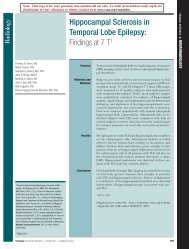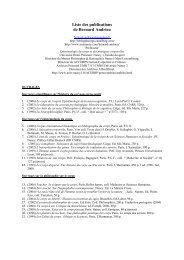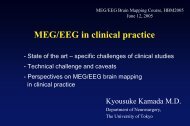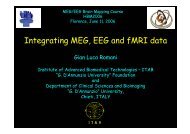th`ese de doctorat - Neurosciences Cognitives & Imagerie Cérébrale ...
th`ese de doctorat - Neurosciences Cognitives & Imagerie Cérébrale ...
th`ese de doctorat - Neurosciences Cognitives & Imagerie Cérébrale ...
You also want an ePaper? Increase the reach of your titles
YUMPU automatically turns print PDFs into web optimized ePapers that Google loves.
2802Acute and Follow-up MCA infarct probability maps in stroke patients with MCA occlusionC. Rosso 1,2 , G. Auzias 2 , R. Cuingnet 2 , S. Crozier 1 , E. Bardinet 2,3 , S. Lehéricy 2,4 , S. Baillet 2 , and Y. Samson 11 Stroke center, Pitie Salpetriere Hospital, Paris, France, 2 Cognitive neuroscience and Brain Imaging Laboratory, CNRS-UPR 640 LENA,Pitie Salpetrière Hospital, University Pierre and Marie Curie, Paris, France, 3 Center for NeuroImaging Research, Pitie Salpetriere Hospital,Paris, France, 4 Department of Neuroradiology, Pitié Salpetrière Hospital, University Pierre and Marie Curie, Paris, FranceObjectivesHere, we investigated infarct growth (localization, pattern) in stroke patients with acute Middle Cerebral Artery(MCA) occlusion, To this aim, we generated stereotaxic MCA infarct probability maps using Diffusion-Weightedimages (DWI) obtained during the therapeutic window (< 6 hours) and at follow-up in patients with or withoutMCA arterial recanalization.Material and MethodsWe selected 53 patients (median age: 68 years, range 26-84) with acute MCA stroke and occlusion of the trunk ofthe MCA (M1) who un<strong>de</strong>rwent initial MRI including DWI within the first six hours of stroke onset (median <strong>de</strong>lay of2.5 hours; IQR: 1.9-3.4 h) and control MRI in the next few days. Recanalization was assessed on the follow-up MRangiography. The T2 weighted images (b0) were normalized to the MNI T2 template and the DW images (b1000)were transformed using the same parameters using SPM5. The acute and follow-up MCA infarct probability mapswere created by segmentation and superposition of the normalized DWI hypersignals obtained at the acute stage andat follow-up. In addition, follow-up infarct probability maps were computed in recanalized (n=37) and nonrecanalized(n=16) patients, and superimposed to a corticospinal tract (CST) template for interpretation 1 .ResultsFigure 1 displays the acute and the final MCA probability maps. Voxels with the highest probability of infarctionwere localized in the <strong>de</strong>ep white matter of the frontal lobe (x:-26, y: 14, z: 24; probability of infarction=0.71) for theinitial map, and in the region of the external capsule and lateral part of the lenticular nucleus for the follow-up map(x: -33, y: -9, z: 6; probability=0.87). Boundaries of our follow-up MCA probability map were visually in good linewith those previously <strong>de</strong>scribed. On the follow-up probability map, the probability of infarction of the <strong>de</strong>ep MCAterritory and periventricular white matter was much higher in non recanalized patients than in recanalized patients,and than on the initial (< 6 hours) infarct probability map. Furthermore, the probability of CST infarction was alsomuch higher in the absence of arterial recanalization. (Figure 2).Figure 1. Acute (left) and follow-up (right) probability maps. Color scale indicates the percentage of subjectspresenting an infarct for each voxel of the image. Probability of infarction was higher in the <strong>de</strong>ep MCA territory atfollow-up than at the acute stage.Figure 2. Superposition of the corticospinal tract template (dark) with the 50% probability of infarction in nonrecanalized(left) and recanalized (right) patients (in red). Most of the CST was involved in non-recanalized patientswhereas it was largely spared in recanalized patients.Conclusion: In acute stroke patients, MCA arterial recanalization <strong>de</strong>creased the probability of infarction in the <strong>de</strong>epMCA territory and the corticospinal tract.References1- Bürgel et al, NeuroImage 2006;29:1092-1105.






